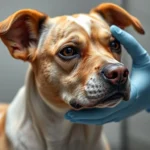
Introduction
Papilloma is a term that describes benign tumors caused by the canine papillomavirus (CPV) in dogs. These growths, although generally non-cancerous, can cause concern for dog owners due to their appearance and potential for discomfort. Understanding what papilloma means in the context of your dog’s health is vital for every pet owner.
For dog owners, recognizing and understanding health issues like papilloma is crucial. Early detection and appropriate treatment can make a significant difference in your dog’s well-being. This article aims to provide a comprehensive overview of papilloma in dogs, including its symptoms, diagnosis, treatment options, and preventive measures.
Understanding Papilloma in Dogs
What is Canine Papillomatosis?
Canine papillomatosis refers to the condition characterized by the presence of warts or growths caused by the canine papillomavirus. These tumors can manifest in various forms, primarily categorized into two types: cutaneous papillomas and oral papillomas.
-
Cutaneous Papillomas: These are typically found on the skin and can appear as small, fleshy growths. They are often round and may resemble warts.
-
Oral Papillomas: These growths occur in the mouth, often affecting the gums, tongue, or lips. They can interfere with eating or drinking and may cause discomfort.
Causes of Papilloma in Dogs
Viral Origin
The primary cause of papilloma in dogs is the canine papillomavirus (CPV). This virus belongs to a larger family of viruses known to cause warts in various species. Once a dog is infected, the virus can lead to the development of papillomas over time.
Transmission
Papillomas are considered contagious among dogs. The virus spreads primarily through direct contact with infected dogs or contaminated surfaces. Puppies and younger dogs are particularly susceptible, as their immune systems may not be fully developed.
Risk Factors
Certain factors can increase the likelihood of a dog developing papilloma:
-
Age: Young dogs, especially those under two years old, are at a higher risk due to their immature immune systems.
-
Immune System Health: Dogs with compromised immune systems are more susceptible to infections and may be more likely to develop papillomas.
-
Breed Predispositions: Some breeds may be more prone to developing papillomas than others, although any dog can be affected.
Symptoms of Papilloma in Dogs
Common Signs
Identifying the symptoms of papilloma in dogs is crucial for early intervention. Common signs include:
-
Visible Growths: These may appear as small, raised bumps on the skin or inside the mouth. They can vary in size and color, often resembling cauliflower.
-
Location of Growths: Papillomas commonly appear in the mouth, on the face, and on the paws. In some cases, they can also be found on other parts of the body.
Behavioral Changes
In addition to physical symptoms, dogs with papilloma may exhibit behavioral changes:
-
Eating or Drinking Difficulties: Oral papillomas can cause pain or discomfort while chewing or swallowing, leading to changes in eating habits.
-
Signs of Discomfort: Dogs may paw at their mouths, whine, or show signs of distress if the papillomas cause irritation.
Diagnosis of Papilloma in Dogs
Veterinary Examination
When a dog presents with suspicious growths, a veterinary examination is essential. During the visit, the vet will:
- Conduct a thorough physical examination, assessing the size, location, and characteristics of the growths.
- Take a detailed medical history to identify any potential risk factors, such as recent exposure to other dogs or changes in health.
Diagnostic Tests
To confirm the diagnosis of papilloma, the veterinarian may recommend several diagnostic tests:
-
Biopsy: A small sample of the growth may be taken for analysis.
-
Cytology: The vet may also perform cytological examinations to check for abnormal cells.
-
Histopathology: This laboratory analysis of tissue samples is crucial for confirming the diagnosis and ruling out other conditions.
Treatment Options for Papilloma in Dogs
Monitoring and Observation
In many cases, particularly with small and asymptomatic papillomas, the best course of action may be to simply monitor the growths. Many papillomas will resolve on their own as the dog’s immune system matures and fights off the virus.
Medical Treatments
If the papillomas are causing issues or do not resolve on their own, the veterinarian may recommend medical treatments. These can include:
-
Antiviral Medications: In some cases, antivirals may be prescribed to help combat the virus.
-
Immune Boosters: Medications that enhance the immune response can also be beneficial.
Surgical Options
Surgery may be necessary if the papillomas are large, painful, or located in areas that interfere with normal function. Surgical removal involves:
-
Procedure Overview: The vet will carefully excise the growths under anesthesia.
-
Recovery: Post-surgery, the dog may need to wear an Elizabethan collar to prevent licking the surgical site and should be monitored for any signs of infection.
Alternative Treatments
Some dog owners may consider alternative treatments for papillomas. While holistic approaches might be appealing, it’s essential to consult a veterinarian before starting any new treatment. Options may include:
-
Homeopathy: Some natural remedies may help boost the immune system or reduce symptoms.
-
Natural Remedies: Certain herbal treatments are believed to have antiviral properties, but their efficacy and safety should be evaluated by a professional.
Caring for a Dog with Papilloma
Post-Treatment Care
After treatment for papilloma, proper care is essential for recovery. Guidelines include:
-
Follow-Up Visits: Regular veterinary check-ups are crucial to monitor healing and ensure no new growths develop.
-
Wound Care: If the dog has undergone surgery, care for the incision site is vital to prevent infection.
Home Care Practices
At home, dog owners can take several steps to promote healing:
-
Daily Care Routines: Keep the dog’s environment clean and free of irritants.
-
Nutritional Considerations: A balanced diet can support the immune system, aiding in recovery.
Prevention of Papilloma in Dogs
Vaccination and Health Screening
Preventive care is essential for reducing the risk of papilloma:
-
Regular Veterinary Check-Ups: Routine health screenings can help catch health issues early.
-
Vaccination: While there is no specific vaccine for the canine papillomavirus, ensuring your dog is up-to-date on vaccinations can help prevent other viral infections.
Good Hygiene Practices
Maintaining good hygiene is crucial in preventing the spread of papillomavirus:
-
Clean Environment: Regularly clean your dog’s living space to reduce the risk of virus transmission.
-
Social Interaction: Monitor your dog’s interactions with other dogs, especially in communal spaces like dog parks.
Socialization and Exposure
Managing your dog’s social interactions can help prevent papilloma:
-
Controlled Playdates: Choose familiar and healthy playmates for your dog.
-
Monitoring: Keep an eye on your dog during interactions with other dogs, looking out for signs of illness.
Conclusion
In summary, understanding papilloma in dogs is essential for maintaining your pet’s health. From recognizing symptoms to exploring treatment options, being informed can empower you as a dog owner. Ensure regular veterinary care and be observant of any changes in your dog’s health, as early detection and intervention can make all the difference.
If you suspect your dog may have papilloma or observe any unusual growths, it’s vital to consult your veterinarian for guidance and care.









